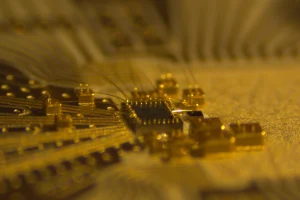Australian National University scientists have engineered a room-temperature enclosure in which to concentrate ‘exciton polaritons’ – an exotic form of energy and matter with potential for optoelectronics in transition-metal dichalcogenide monolayers, such as tungsten disulphide. The exciton polariton is a hybrid particle composed of an exciton, formed from a bound electron-hole pair, and a photon. They are “a promising platform ...
Research
The latest electronics research news from within the industry and universities from around the world.
2D molecule absorbs 90% of ~10GHz radiation for X-band electromagnetic protection
Vanadium carbide ‘MXene’ two dimensional materials can absorb up to 90% of electromagnetic radiation between 8.2 and 12.4GHz, according to Drexler University, out-performing more conventional materials for protecting objects against detection by X-band radar. This is not the first time MXenes have been used to block radio waves – titanium carbonates have been studied, for example – but they are ...
The world is a classroom
Sara Pellegrini, advanced photonics pixel architect, STMicroelectronics, talks to Caroline Hayes about her work, her research and how to encourage students to be curious about what’s inside today’s electronic devices. Sara Pellegrini is based in Edinburgh, her home since she arrived at Heriot-Watt University as part of a PhD project in SPAD (single photon avalanche diodes). She is responsible for ...
New cathode material for li-ion EV batteries
Skoltech researchers have developed a novel material for lithium-ion batteries powering electric vehicles. The material is a familiar nickel-rich layered transition metal oxide, but with an altered microstructure that packs more energy per unit volume. “The cathodes in batteries powering electric cars tend to use layered transition metal oxides, including nickel-rich ones. We improved two commonly used materials of this kind, achieving a ...
Imec develops pMUT array compatible with FPD technologies
Imec has developed a piezoelectric Micromachined Ultrasound Transducer (pMUT) array that is compatible with flat-panel-displays (FPD) process technologies. The array demonstrates acoustic pressures in mid-air above 1kPa, a pressure level relevant for enabling mid-air haptics and directed sound. Moving from wafer-based to FPD-compatible processes prepares the pMUT technology for the integration of future mid-air applications, such as vibro-haptics, time-of-flight (3D) ...
Ionics replace electronics in an analogue 16 x 16 multiplier
Harvard scientists have managed to create a processing circuit usign ionics rather than electronics. Working with biotech start-up DNA Script, they designed an ionic transistor which consists of an aqueous solution of quinone molecules, interfaced with two concentric ring electrodes with a centre disc electrode (see photo). The ring electrodes electrochemically lower and tune the local pH around the centre disc ...
Elektra 2022 University Research award launches – Cast your vote!
The University Research category for the Elektra Awards 2022 is launching, sponsored by Panasonic – with the awards in their twentieth year – and we are looking to readers to express their choice and help determine the winner. You are invited to select the university research project from the last year that you feel will make the largest impact on ...
Perovskite solar to shine at Cambridge Symposium
A two-terminal all-perovskite tandem solar cell with 24.1% power conversion efficiency and over 2V open-circuit voltage will be amongst the state-of-the-art perovskite research revealed in late October at the Cavendish Laboratory’s third Cambridge Cluster Tool symposium. Fine control of halide content in the cell is used to widen the bandgap, a self-assembling mono-layer is used for hole transport, and the ...
TIA IC accommodates 50 Gbit/s NRZ and 100 Gbit/s PAM-4 modulation
Researchers from IDLab (an imec research group at Ghent University and the University of Antwerp, Belgium) and Nokia Bell Labs have presented the first upstream linear burst-mode transimpedance amplifier (TIA) chip that accommodates 50 Gbit/s NRZ and 100 Gbit/s PAM-4 modulation. The chip enables optical line terminals (OLTs) to cope with upstream packets’ varying signal strength and quality degradation; effects ...
Modelling grid effects of electric vehicle charging in the next decade
Researchers at Stanford University have modelled over-night home charging of electric vehicles and predict that it is not the correct strategy, for the Western US at least. Simulation is based on a model, revealed in March, for charging demand that can be applied to different human populations under different conditions. In a demonstration, they have now applied it to the ...
 Electronics Weekly Electronics Design & Components Tech News
Electronics Weekly Electronics Design & Components Tech News

